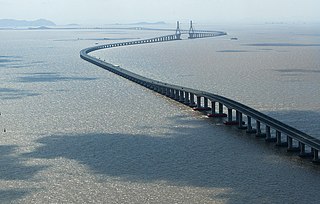
Transport in China has experienced major growth and expansion in recent years. Although China's transport system comprises a vast network of transport nodes across its huge territory, the nodes tend to concentrate in the more economically developed coastal areas and inland cities along major rivers. The physical state and comprehensiveness of China's transport infrastructure tend to vary widely by geography. While remote, rural areas still largely depend on non-mechanized means of transport, urban areas boast a wide variety of modern options, including a maglev system connecting the city center of Shanghai with Shanghai Pudong International Airport. Airports, roads, and railway construction will provide a massive employment boost in China over the next decade.
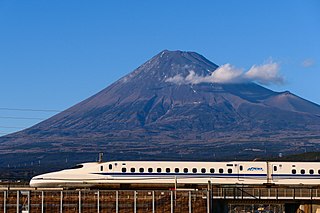
High-speed rail (HSR) is a type of rail transport network utilizing trains that run significantly faster than those of traditional rail, using an integrated system of specialized rolling stock and dedicated tracks. While there is no single standard that applies worldwide, lines built to handle speeds above 250 km/h (155 mph) or upgraded lines in excess of 200 km/h (124 mph) are widely considered to be high-speed.

Transrapid is a German-developed high-speed monorail train using magnetic levitation. Planning for the Transrapid system started in 1969 with a test facility for the system in Emsland, Germany completed in 1987. In 1991, technical readiness for application was approved by the Deutsche Bundesbahn in cooperation with renowned universities.
Inductrack is a passive, fail-safe electrodynamic magnetic levitation system, using only unpowered loops of wire in the track and perslide magnets on the vehicle to achieve magnetic levitation. The track can be in one of two configurations, a "ladder track" and a "laminated track". The ladder track is made of unpowered Litz wire cables, and the laminated track is made out of stacked copper or aluminium sheets.

Maglev is a system of train transportation that uses two sets of electromagnets: one set to repel and push the train up off the track, and another set to move the elevated train ahead, taking advantage of the lack of friction. Such trains rise approximately 10 centimetres (4 in) off the track. There are both high-speed, intercity maglev systems, and low-speed, urban maglev systems under development and being built. The Shanghai maglev train is the only maglev train in commercial operation that can be considered as high speed.
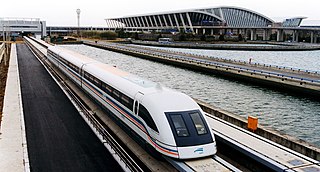
The Shanghai maglev train or Shanghai Transrapid is a magnetic levitation train (maglev) line that operates in Shanghai, China. The line uses the German Transrapid technology. The Shanghai maglev is the world's first commercial high-speed maglev and has a maximum cruising speed of 431 km/h (268 mph), making it the fastest train service in commercial operation.

The Beijing–Shanghai high-speed railway is a high-speed railway that connects two major economic zones in the People's Republic of China: the Bohai Economic Rim and the Yangtze River Delta. Construction began on April 18, 2008, with the line opened to the public for commercial service on June 30, 2011. The 1,318-kilometer (819 mi) long high-speed line is the world's longest high-speed line ever constructed in a single phase.
A vactrain is a proposed design for very-high-speed rail transportation. It is a maglev line using partly evacuated tubes or tunnels. Reduced air resistance could permit vactrains to travel at very high (hypersonic) speeds with relatively little power—up to 6,400–8,000 km/h (4,000–5,000 mph). This is 5–6 times the speed of sound in Earth's atmosphere at sea level.

Plans for high-speed rail in the United States date back to the High-Speed Ground Transportation Act of 1965. Various state and federal proposals have followed. Despite being one of the world's first countries to get high-speed trains, it failed to spread. Definitions of what constitutes high-speed rail vary, including a range of speeds over 110 mph (180 km/h) and dedicated rail lines. Inter-city rail with top speeds between 90 and 125 mph is sometimes referred to in the United States as higher-speed rail.
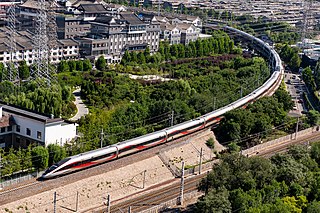
The high-speed rail (HSR) network in the People's Republic of China (PRC) is the world's longest and most extensively used – with a total length of 42,000 kilometres (26,000 mi) by the end of 2022. The HSR network encompasses newly built rail lines with a design speed of 200–350 km/h (120–220 mph). China's HSR accounts for two-thirds of the world's total high-speed railway networks. Almost all HSR trains, track and service are owned and operated by the China Railway Corporation under the brand China Railway High-speed (CRH).
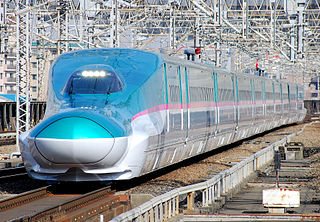
Indian Railways does not currently have any operational high-speed rail lines, though a total of eight corridors have been approved, with the corridor between Mumbai and Ahmedabad under construction. As of 2023, the fastest train services in India are the RapidX, Gatimaan Express and Rani Kamalapati (Habibganj)–Hazrat Nizamuddin Vande Bharat Express with peak operational speed of 160 km/h (99 mph) on the Tughlakabad – Agra Cantonment section of the route.

Hyperloop is a proposed high-speed transportation system for both public and goods transport. The idea was picked up by Elon Musk and SpaceX engineers as a means to disrupt a proposed California High-Speed Rail system and described as a transportation project involving capsules supported by air-bearings in low-pressure environment inside a tube. Hyperloop systems have three essential elements: tubes, pods, and terminals. The tube is a large, sealed low-pressure system. The pod is a coach pressurized at atmospheric pressure that experiences low air resistance or friction inside this tube using magnetic propulsion. The terminal handles pod arrivals and departures. The Hyperloop, in the initial form proposed by Musk, differs from vactrains by relying on residual air pressure inside the tube to provide lift by aerofoils and propulsion by fans; however, many subsequent variants using the name "Hyperloop" have been relatively traditional vactrains.
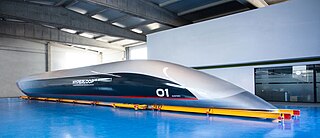
Hyperloop Transportation Technologies, also known as HyperloopTT, is an American research company formed using a crowd collaboration approach to develop around the world commercial transportation systems based on the Hyperloop concept.

Hyperloop One is an American transportation technology company that works to commercialize the high-speed travel concept called the Hyperloop, a variant of the vacuum train. The company was established on June 1, 2014, and reorganized and renamed on October 12, 2017.
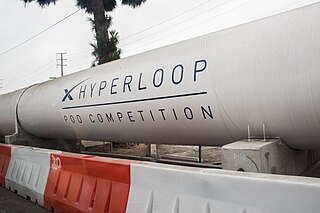
The Hyperloop Pod Competition was an annual competition sponsored by SpaceX from 2015 to 2019 in which a number of student and non-student teams participate to design—and for some, build—a subscale prototype transport vehicle in order to demonstrate technical feasibility of various aspects of the Hyperloop concept. The competitions have been open to participants globally, although all competitions and judging has occurred in the United States of America.
Hyperloop UPV is a team of students from the Universitat Politècnica de València with the aim of designing Hyperloop, a proposed future means of transport. With renewable energies, the vehicle will levitate inside a vacuum tube, being able to reach 1,200 km/h (750 mph).
TransPod Inc. is a Canadian company designing ultra-high-speed transportation technology and vehicles.
Arrivo Corporation was a startup company in Los Angeles, California that developed maglev rail. Arrivo initially attempted to commercialize a hyperloop, but abandoned the effort in November 2017 in favor of established transit technologies.












